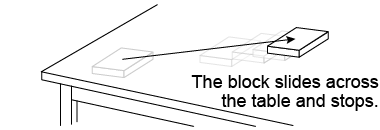- Ask two friends to answer the following question: “Can there ever be a single isolated force?" Ask them to explain why or why not. Write down their answers. How do their answers compare with your own answer to the same question?
- In the lesson on springs, your teacher described the force exerted by a spring. Based on your teacher’s statements, why is there a negative sign in Hooke’s law?
- Why is a spring used in a force scale?
- A spring with a spring constant of k is cut in into three equal-length pieces. What is the spring constant of each of the pieces?

- A mass is connected to two springs as shown above. Each spring has a spring constant of k. What is the effective spring constant that the mass experiences?
- Does a spring scale measure weight or mass? Why?
- How would you calculate the spring constant of an unknown spring?
- Ask two friends to define the meaning of the “spring constant.” Write down their answers. How do their answers compare with your own definition?
- Does adding a lubricant such as oil between sliding surfaces raise or lower the coefficient of friction?

- Sylvie applied a quick push to a motionless friction block, which then slid part way across a table and came to a stop. What kinds of friction were acting on the friction block in her activity?
| | - Why does rubbing your hands together warm them up?
 Why is it difficult to walk on surfaces such as ice that have a low coefficient of static friction? Why is it difficult to walk on surfaces such as ice that have a low coefficient of static friction?
 Consider the model Fk=μkFN. Would a block with a large surface area or a small surface area experience a greater force of kinetic friction, assuming that the blocks have identical mass? Consider the model Fk=μkFN. Would a block with a large surface area or a small surface area experience a greater force of kinetic friction, assuming that the blocks have identical mass?
 A friction block consists of a piece of wood with slotted masses on top of it. If you double the total mass of the block plus slotted masses, how does the coefficient of static friction between the friction block and concrete change? A friction block consists of a piece of wood with slotted masses on top of it. If you double the total mass of the block plus slotted masses, how does the coefficient of static friction between the friction block and concrete change?
- How do you determine the sign of the force of static friction?
- How do you determine the sign of the force of kinetic friction?

 The purpose of tires is to increase static friction between the wheels and the road so that there is no slipping or skidding. With deformable materials such as rubber, the amount of friction, or traction, increases as more rubber surface actually contacts the road. Explain why street-legal tires have treads that decrease the amount of rubber touching the road whereas racing car tires are smooth with no treads. The purpose of tires is to increase static friction between the wheels and the road so that there is no slipping or skidding. With deformable materials such as rubber, the amount of friction, or traction, increases as more rubber surface actually contacts the road. Explain why street-legal tires have treads that decrease the amount of rubber touching the road whereas racing car tires are smooth with no treads.
 Why is it far more efficient to pull a sled with the rope slanting upward instead of downward? Draw a diagram to solve this problem by showing the forces from both an up-slanted and a down-slanted rope. Why is it far more efficient to pull a sled with the rope slanting upward instead of downward? Draw a diagram to solve this problem by showing the forces from both an up-slanted and a down-slanted rope.
 Why do we say that friction models such as F = μFN are only approximations? The models can be used to calculate a friction force to five decimal places with any ordinary calculator. Why do we say that friction models such as F = μFN are only approximations? The models can be used to calculate a friction force to five decimal places with any ordinary calculator.
 A team of physicists studied the world-record-setting sprint by Usain Bolt in 2009. The physicists showed that Bolt exerted a roughly constant horizontal force against the frictional drag forces acting against him. The physicists said the “[drag] force causes a reduction of his acceleration, so his speed tends to a constant value (terminal speed).” A team of physicists studied the world-record-setting sprint by Usain Bolt in 2009. The physicists showed that Bolt exerted a roughly constant horizontal force against the frictional drag forces acting against him. The physicists said the “[drag] force causes a reduction of his acceleration, so his speed tends to a constant value (terminal speed).”
Explain why Bolt reaches a terminal speed by describing the forces acting on him.
|

